In October 2018, I reviewed the KMZ Zenit-E, one of the most well known and identifiable cameras to ever come out of the former Soviet Union. Millions of Zenits were produced from 1952 – 1996 and many of them were the Zenit-E.
When they were first released, the Zenit used a modified M39 lens mount that was later changed to the the “universal” M42 screw mount used by Pentacon, Pentax, and a zillion other companies. There are literally thousands of different M42 lenses made in nearly every focal length and configuration imaginable and they’re all compatible with most Zenits.
The reason I say “most” is that from 1964 to 1968, KMZ, the factory where Zenits were made, released a new series of Zenit cameras known as the Zenit 4, 5, and 6 which other than the name, shared nothing with their screw mount counterparts. These new Zenits were loosely based on the Voigtländer Bessamatic and came with a behind the lens leaf shutter and shared the Bessamatic’s DKL style bayonet lens mount.
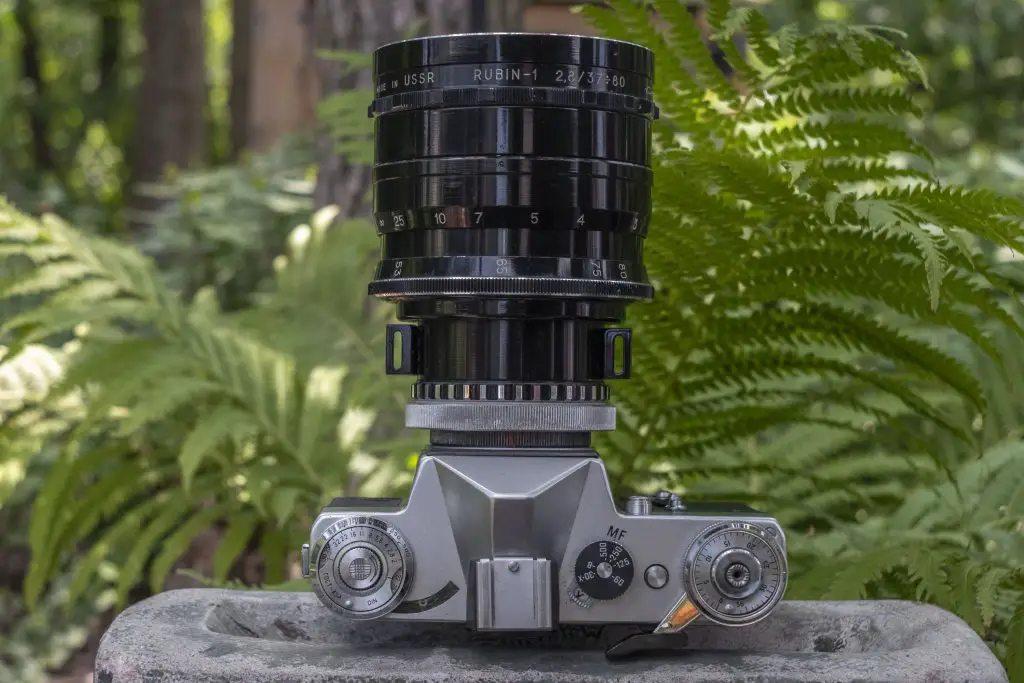 The Zenit 4, 5, and 6 are all basically the same camera with the only difference being the Zenit-5 had a rechargeable battery operated motorized film advance, and the Zenit-6 came with a different standard lens. Both the Zenits 4 and 5 came standard with a Vega-3 50mm f/2.8 lens, but the Zenit 6 came with an all new zoom lens called the Rubin-1. Loosely based on the Voigtländer Zoomar, originally designed by Dr. Frank G. Back as a motion picture lens, the Zoomar is widely considered to be the first successful zoom lens for 35mm.
The Zenit 4, 5, and 6 are all basically the same camera with the only difference being the Zenit-5 had a rechargeable battery operated motorized film advance, and the Zenit-6 came with a different standard lens. Both the Zenits 4 and 5 came standard with a Vega-3 50mm f/2.8 lens, but the Zenit 6 came with an all new zoom lens called the Rubin-1. Loosely based on the Voigtländer Zoomar, originally designed by Dr. Frank G. Back as a motion picture lens, the Zoomar is widely considered to be the first successful zoom lens for 35mm.
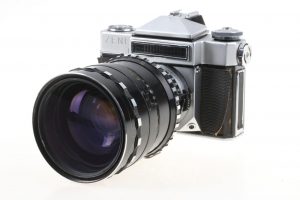
I say “loosely based” on the Zoomar as the two lenses are quite different. For one, the physical construction of the lens is different. Both lenses have 14-elements in 11 groups, but the position of the individual elements is not the same. Another difference is that the zoom range is not exactly the same. The Zoomar has a slightly wider range of 36mm to 82mm, whereas the Rubin is 37mm to 80mm. How you zoom the lens is different too. The Zoomar has a “push to zoom” ring, whereas the Rubin uses a more traditional twisting motion.
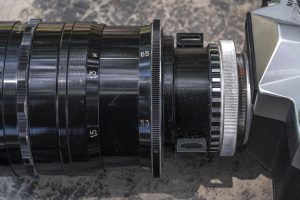
I lack a strong understanding of how lenses are constructed, so maybe there’s more internal similarities than the external specs might suggest, but I don’t think it’s accurate to consider the Rubin a copy of the Zoomar. Nevertheless, both the Zoomar and Rubin are very early examples of a zoom lens for 35mm, but with a Soviet version of the DKL mount, it’s not a lens that’s easily adapted to other cameras.
Luckily, Soviet collectors are a resourceful bunch, and modifying the Rubin’s mount and replacing it with a standard M42 screw mount was commonly done, allowing the lens to be used on a variety of Zenits and other similar cameras.
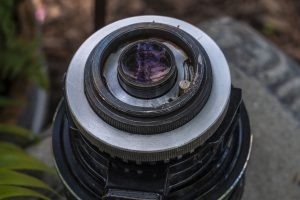
I picked up this M42 modified Rubin-1 when my friend Vlad from ussrphoto.com alerted me to one from a collector in Russia. Vlad has contacts in former Soviet countries who will often look for things for him and build up a large shipment of stuff, and send it all at the same time using a local courier to save on shipping. Since he has to wait for an entire shipment to come, it took several months before I was able to pick up the lens from him, but when I did, my first observation was…
Holy cow, this thing is heavy! If you consider the Zenit to be a pretty solid hunk of metal, when mounted together, the weight of the lens and camera is 1793 grams, making it the heaviest camera and lens combination in my entire collection. Even without the weight of the Zenit hanging off the back of the lens, by itself, the Rubin-1 is 1094 grams of solid metal and glass.
Everything about this lens is big, from it’s weight, to it’s 82mm front filter ring. This example came with a Hoya HMC Super UV filter on it which was a nice bonus, especially considering that filter had a list price of $67 when it was sold (it’s no longer available).
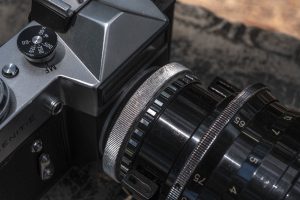
Using the M42 modified Rubin-1 is a little tricky because the original DKL mount did not have any method for stopping down the iris on the lens itself. The DKL mount as used on the original Zenit 4, 5, and 6, Kodak Retina Reflex, Voigtländer Bessamatic and others, has the aperture control on the lens mount, not the lens. Selecting a different f/stop on those cameras simply moves a pin in the lens that causes the iris to open and close.
When the Rubin is modified to M42 mount, the ability to select f/stops must be added to the lens. On this example, a metal ring near the base of the lens mount needed to be added. Whoever did this modification did not bother to include f/stop numbers, rather just etched a couple different lines at the various positions where the lens is at f/2.8 through f/16 (I assume). Since the marks are not labeled and there’s no click stops, it can be a bit tricky to know exactly which f/stop you’ve selected. While shooting, I just assumed that whatever the halfway position I had it at, was around f/8 to f/11.
I really wanted to test the Rubin with a Soviet era film but didn’t have any at the time I was motivated to take the camera and lens out, so I chose some slightly expired Kodak Tri-X 400. I figured the medium amount of grain typical of that film, combined with the late winter days I would shoot the camera and lens might pair well.
As recently as the 1970s and 80s, zoom lenses were generally considered inferior to primes due to the larger number of moving elements within the lens. The Rubin has 14 elements compared to a Zeiss Tessar which has 4 elements, so the increase in glass also can have a negative affect on sharpness and increase the chances of refraction and other anomalies. If manufacturers struggled with this in the 1980s, how would a Soviet built copy of a lens first designed in the 1950s fare?
Every one of the images above show a noticeable softness across the entire image that gets worse near the edges. The Zenit-E has a pretty dark viewfinder to begin with, and mounting a slower zoom lens only makes it worse, so I did struggle to see focus in a few instances. I noticed that softness increased at the longer end of the lens. At it’s widest, sharpness is good, but as I zoomed in, you can clearly see that the lens struggles.
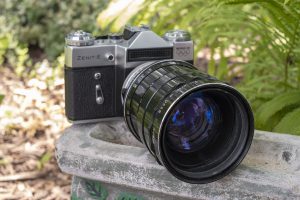
Vignetting was surprisingly keep to a minimum. Vintage wide angle lenses often show a pronounced darkness near the corners, and in shots taken at 37mm, I really didn’t notice any significant vignetting which suggests that coverage of the lens is far greater than a 24x36mm image.
Perhaps the worst characteristic I noticed with the Rubin is a low contrast “haze” in nearly every image. I put haze in parenthesis as looking through the lens, I didn’t see any of the typical haze you see in older lenses, but I believe that with the complexity of the Rubin’s 14 elements, there’s a lot of light bouncing around in there lowering contrast. It’s certainly not bad, and can be improved in post processing, but certainly affects the “pop” you expect of a quality lens.
It’s easy to be critical of these images looking at them on a high resolution LCD computer monitor, but it’s important to remember that the original users of these lenses shot them on modest quality black and white film and likely never had them printed on anything larger than 5×7.
While none of my observations would have likely been deal breakers for a 1960s Soviet photographer who would have originally purchased this lens, there is a limit of how much detail you can see in a lens using film, so I naturally wondered how this lens would perform when adapted to digital. Using an M42 to Fuji X-mount adapter, I mounted the lens to my Fujifilm X-T20 digital mirrorless.
Having the benefit of a pixel peeping 24.3 megapixel digital sensor, we can more clearly see what the Rubin-1 is capable of. For starters, many of my observations with the black and white film images above are still here. The lens is still pretty soft at the longer end. The image of the tree is from about a quarter of a mile away and loss of sharpness is prevalent throughout the entire frame. Vignetting is kept to a minimum, but edge softness is an issue in nearly every image.
With these being my first color images shot through the Rubin, it is clear that the softness around the edges seen in the black and white images also have huge amounts of chromatic aberrations. Controlling the different wavelengths in the color spectrum is a challenge for any lens builder and is one that the Rubin doesn’t come close to mastering.
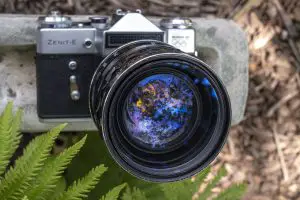
On the plus side though, colors are rendered very naturally. The deep blue coating on the front and rear elements (I am unsure if the inner elements are coated too) are doing a good job at keeping colors vibrant without any noticeable tint. Whatever coating KMZ used has held up well over the years, not showing any yellowing typical of mid century lens like those made by Asahi (Pentax) and Kodak.
Out of focus details in the flower images are also extremely smooth and pleasing to my eye. I wouldn’t go as far as to declare the Rubin as a “bokeh-master”, but for those of you looking for creamy backgrounds to your closeups, this lens does an excellent job of it. Of all the negative things I can say about the Rubin, it’s the out of focus details that will bring me back to this lens again. In hindsight, the softness of the lens might make it ideal as a portrait lens as people tend to like soft focus details on people’s faces.
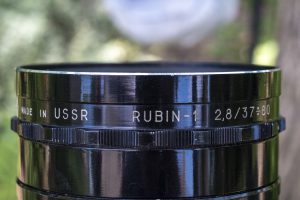
The Rubin-1 is a fascinating lens, not just because of it’s heft and size, but it’s historical significance as being the first Soviet zoom lens, being based on the also historically significant Zoomar, and the fact that it can be adapted to use on M42 cameras makes this something worth checking out if you have the opportunity.
There are significant optical flaws in this lens compared to a more modern one, but that’s not the point. The look you get, especially with it’s creamy out of focus details, makes it a winner in my book. Reviewing an optically perfect lens is boring as there’s nothing to talk about. Reviewing a lens like the Rubin-1 where there’s so much to talk about is much more interesting.
If you can live with a flawed, but interesting, and extremely heavy lens, the Rubin-1 might be the lens for you!

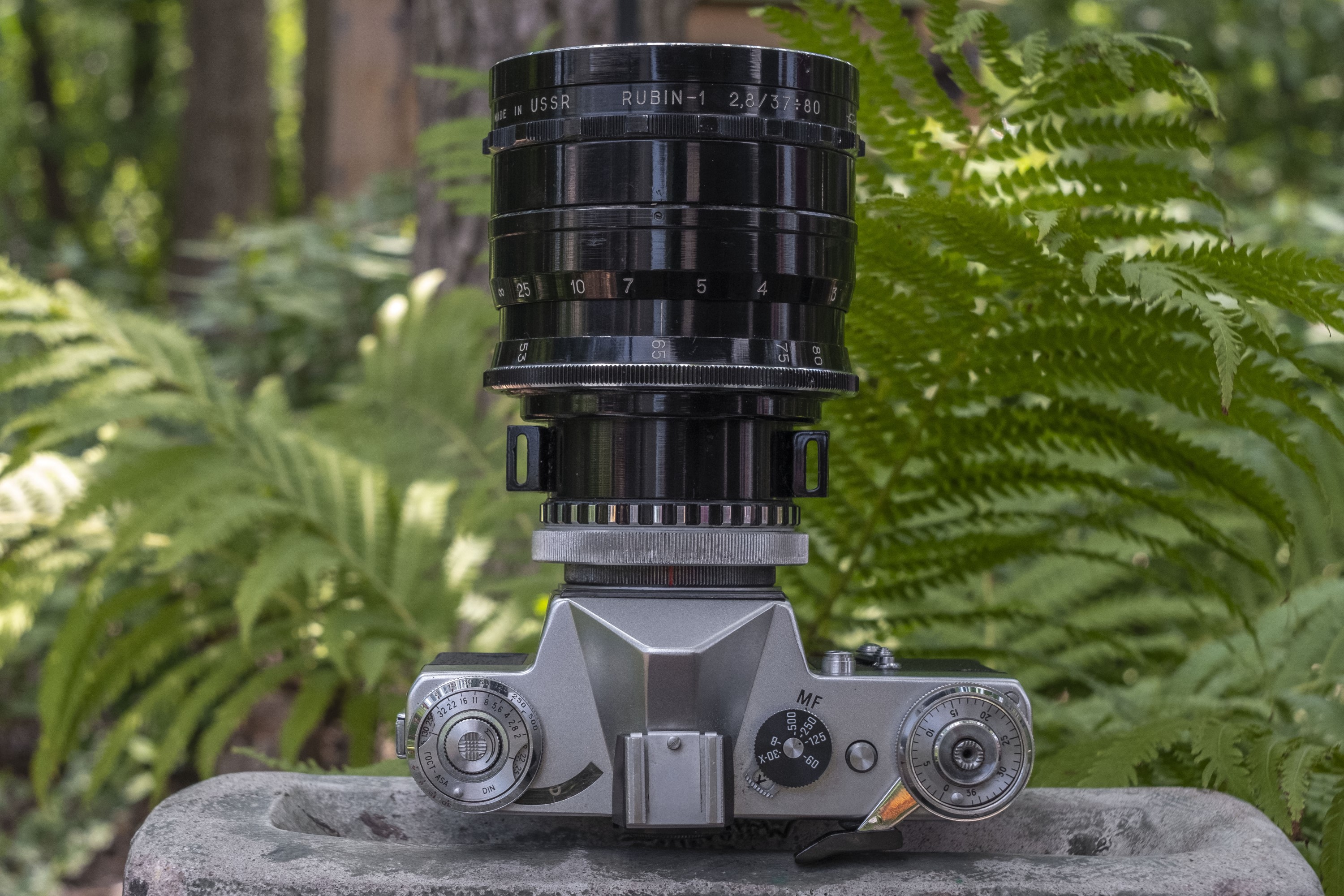
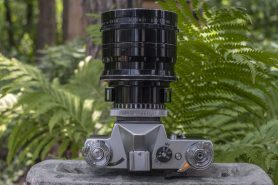

























Really interesting article as always Mike. That lens is fascinating. I hadn’t even heard of it till now. Is that the old Zenit I sent you getting the workout with the Rubin.? If so, glad you took it off the shelf if only to use with this strange but cool looking lens. Hope you and the family are well and staying safe.
Yes Paul, this is the same Zenit you graciously donated to me a while back. Since that review, I’ve shot it a couple of times and while it is a rudimentary camera, I have always enjoyed it. With this Rubin-1 on it, it truly has become a unique photographic tool!
Really appreciated this review, as I’ve seen some good words about this lens from our Ukranian analog friends. The yellow / gold color of older Takumar lenses, particularly early examples of the 50/1.4, are a result of the thorium-rich glass in some of the elements, not of the coating … or so I understand from Pentax Forums.
Hey Mike! Just stumbled on this article after I found a copy of the Rubin 1 on eBay. I’m an avid analog photographer but I do a lot of digital cinematography work for up and coming bands in my local music scene of the twin cities. I’ve been looking for a fast zoom lens with some unique characteristics to add to my quiver of lenses when I need to shoot quick and don’t have time to switch between prime lenses. I’ve been trying to see if there’s a good way to adapt this lens to Sony e mount because from my understanding this lens has a slightly different flange distance from the dkl mount which fotodiox makes an adapter for. Your m42 converted copy may be my answer! With current events being taken into consideration, it may be tricky to find one. Nevertheless I’ll be scouting eBay for a copy. Again thanks so much for this well written and open minded review of what promises to be a far lens clinical lens than the modern offering. Hope your doing well, and shooting a lot!
Glad you found the review useful! As for the original version of this lens, you may be right that the flange distance is different than that of a standard DKL lens, but that is not something I have ever heard. To the best of my knowledge, it is the same. KMZ made the Zenit 4, 5, and 6 as a “sorta” copy of the Voigtländer Bessamatic which also has the DKL mount. I would think that the original Rubin 1 would fit your camera without an issue, but truthfully, I’ve never tried it. Whichever direction you decide to go, good luck!
Very tempted to pick one of these up on ebay! One question I can’t seem to find an answer to, is this lens parfocal?
Dear Mike,
I have a Zenit 6 with the Rubin-1 lens, a kit (including the brown leather pouch it came in) that my dad bought second-hand in the early 70s in Orenburg, for 100 rubles. He’s travelled all over the world with that camera, shooting mostly Kodak and we have a lot of blurry pictures to prove it. Some even have trees in focus in the background if you’re into that sort of thing.
Dad had his camera repaired in 1986 during another trip to Russia, but the repair was of very poor quality and the camera has sat in a cupboard pretty much since. The lens itself has some dust inside and the iris blades may be damaged, or at least covered in gunk, as they are quite sticky.
Years later, I saw this review of the Rubin-1 lens, and the black and white pictures you took (with that expired Kodak film) hit me right in the feels like a ton of bricks. I’ve since picked up the camera from my parents’ house and will try to resurrect the lens by adapting it to an EOS-M I bought last year. I have two EF to EOS-M adapters (a 7Artisans hollow adapter and a Viltrox speedbooster) and I also bought a EF to DKL adapter of Aliexpress.
This is where things are getting interesting. One of the lens ledges is 37.5mm pretty much on the nose, but the adapter ring is slightly smaller at 37.3mm, so the two don’t mate.
The DKL adapter is going on a lathe tomorrow and hopefully I can very carefully shave some metal off and make it work.
Anyway, well done on the review and photographs. At least to me, you 100% nailed the look I remember from my dad’s pictures…
Cheers,
John
PS: If I make any noteworthy progress, I’ll send you an update.